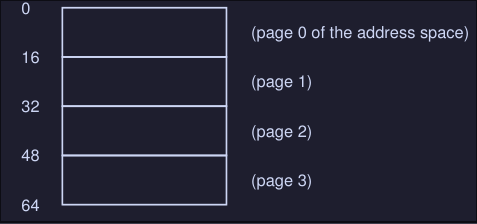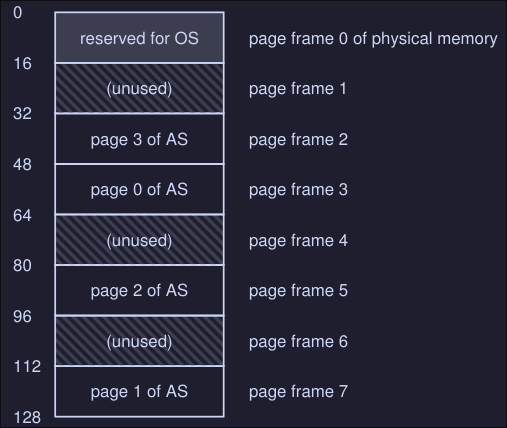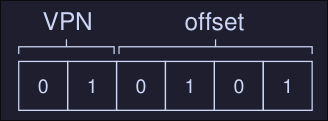Paging - Introduction
Basic definition: We chop up space into fixed-sized pieces, this is known as paging
- We divide a process's address space into fixed-sized units, each of which we call a page
- Physical memory is view as an array of fixed-sized slots called page frames
- Each page frame contains a single virtual-memory page
Example
Imagine we have a small address space of 64 bytes, with four 16-bytes pages.

And that we have physical memory which consists of fixed-size slots, in this case 8 page frames.

Here we have:
- A 128 bytes physical memory
- 8 page frames (from 0 to 7)
- Each page of the address space mentioned at the beginning is located somewhere in memory (not necessarily in order)
Advantages of paging:
- Flexibility
- Simplicity: If the OS wishes to place to place our 64 byte address space into our 8-page physical memory, it simply finds four free pages, perhaps the OS keeps a free list and just grabs the first 4 free page that finds
Usually the OS keeps a per process data structure known as page table:
- It store the address translation for each of the virtual pages of the address space of the process
- This let us know where in physical memory a virtual page resides
- In our example the page table would be something like this:
(Virtual Page 0 -> Physical Frame 3)
(Virtual Page 1 -> Physical Frame 7)
(Virtual Page 2 -> Physical Frame 5)
(Virtual Page 3 -> Physical Frame 2)
Example memory access
- We have the address space described at the beginning
- We want to perform a memory access:
movl <virtual address>, %eax
Lets focus on how to translate the virtual address:
- We need to split it into two components:
- Virtual page number (VPN) (This will help us map our virtual page number to a physical frame number)
- The offset within the page
Since our virtual address space is 64 bytes, we need 6 bits total for our virtual address (2^6 = 64) This is because we can only reference 64 locations, and each location is 1 byte. We CAN'T reference a specific bit, the smallest addressable unit is a byte
Our virtual address can be seeing as this:
| Va5 | Va4 | Va3 | Va2 | Va1 | Va0 |
|---|
Here the highest order bit is Va5 and the lowest order bit is Va0. Also we know that the page size is 16 bytes, hence we only need 4 bits to address the virtual memory inside our page (2^4=16), finally our 2 remaining highest order bits can be used to know which page number are we in.
[Va5, Va4] -> VPN
[Va3, Va2, Va1, Va0] -> Offset
If we know want to load, for example, virtual address 21:
movl 21, %eax
We know that 21 in binary is 010101, hence we have the following virtual address:

We know that our VPN = 01 = 1 and that our offset = 0101 = 5, hence our virtual address is on the first virtual page with offset of 5 bytes.
From our page table we know that virtual page 1 corresponds to Physical Frame 7, then we can replace the VPN with the PFN (Physical frame number) and then issue the load to physical memory:

The offset stays the same because it tells us which byte within the page we want to address.
What's in the page table
- Page table is a data structure used to map virtual address to physical addresses, it a per process data structure, meaning each process has a page table
- Simplest form: Linear page table (Just an array)
- Linear page table indexes the array by the virtual page number and looks up the page-table entry (PTE) at that index to find the physical frame number (PFN).
- For example if I wanted to translate the virtual page number 3 to physical frame number, I would access
array[3]array index 3.
What's inside a Page-table entry (PTE)
-
Each PTE has a number of different bits worth understanding at some level.
-
Valid bit: Indicates if a translation is valid. When a process start running, it will have stack and code at one end of his address space, and heap on the other end. All the space in between is unused hence it will be marked invalid. By marking all the unused pages in the address space, we remove the need to allocate physical frames for those pages, thus saving memory.
-
Protection bits: Indicates if the page can be read, written or executed.
-
Present bit: Indicates if the page is on physical memory or disk (swap on Linux)
-
Dirty bit: Indicates whether the page has been modified since it was brought into memory
-
Reference bit: Track whether a page has been accessed, it helps us to determine which pages are "popular" and thus should be kept in memory.
An example page-table entry would look like this for the x86 architecture:

The problem with paging: Too slow
Imagine we want to access memory 21 on our example's address space:
movl 21, %eax
To do this we would need to translate virtual address space (21) into the physical address (117). Hence, before fetching the data from address 117, our system needs to:
- Fetch the page table from the process's page table
- Perform the trasnlation
- Load the data from physical memory To do so, the hardware must known where the page table is for the current process, let's imagines that this is on a cpu register, then our translate would look like this:
VPN = (VirtualAddress & VPN_MASK) >> SHIFT
PTEAddr = PageTableBaseRegister + (VPN * sizeof(PTE))
offset = VirtualAddress & OFFSET_MASK
PhysAddr = (PFN << SHIFT) | offset
- On our first line we take our virtual address and apply a
VPN_MASKto keep only the bits that represent or virtual page number, on our example, with virtual address21we would have:- 21 in binary is
010101 - Our
VPN_MASKwould be110000(we only need our most significant bits) SHIFTwould be 4, because we want to move our bits 4 spaces to the rightVPN = (010101 & 110000) >> 4 = (010000) >> 4 = (000001)
- 21 in binary is
- The second line would take the memory address of the page table and add the index (
VPNmultiplied by the size of the entries in the tablesizeof(PTE)) to get the page table entry address - Once the
PTEAddr(page table entry address) is known, the hardware can load and extract the PFN (physical address of the page frame) - On the last line, we use the
PFNand left shift it and append theoffsetto get the final physical address space - We can finally fetch the data from the physical address
If you notice, we need to make one extra memory reference (we need to fetch the PTE) in order to get the initial memory address (21 in this case).